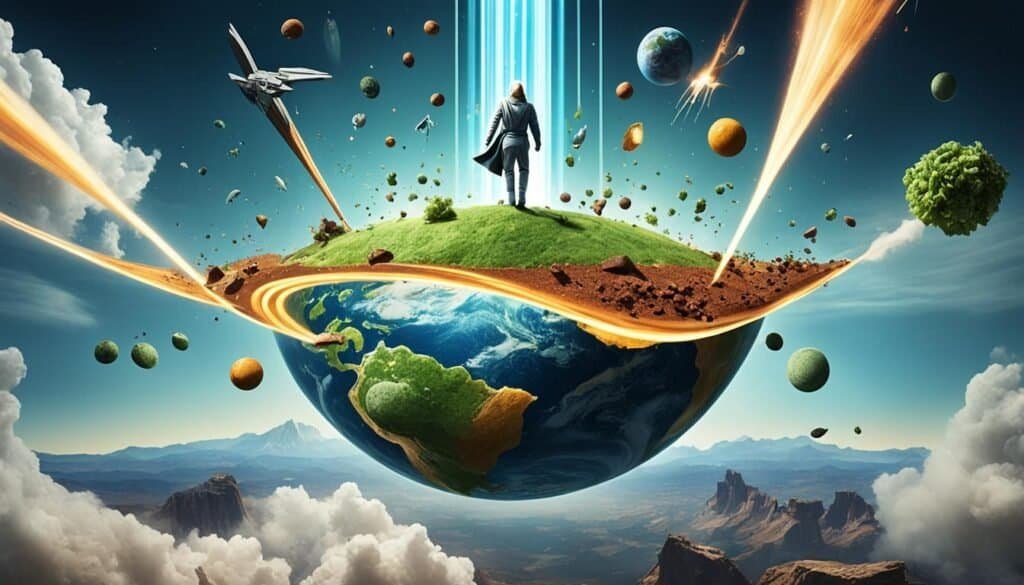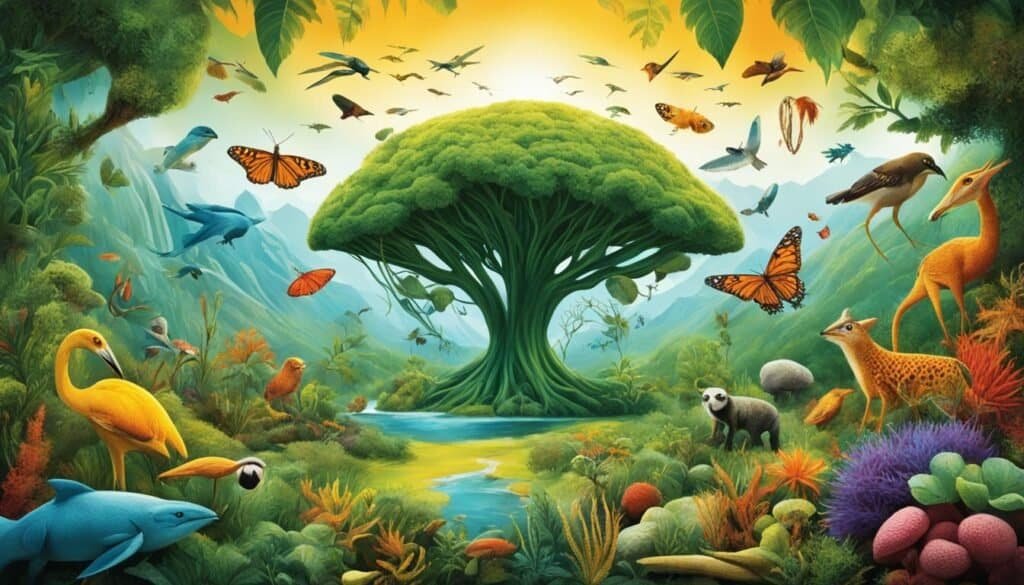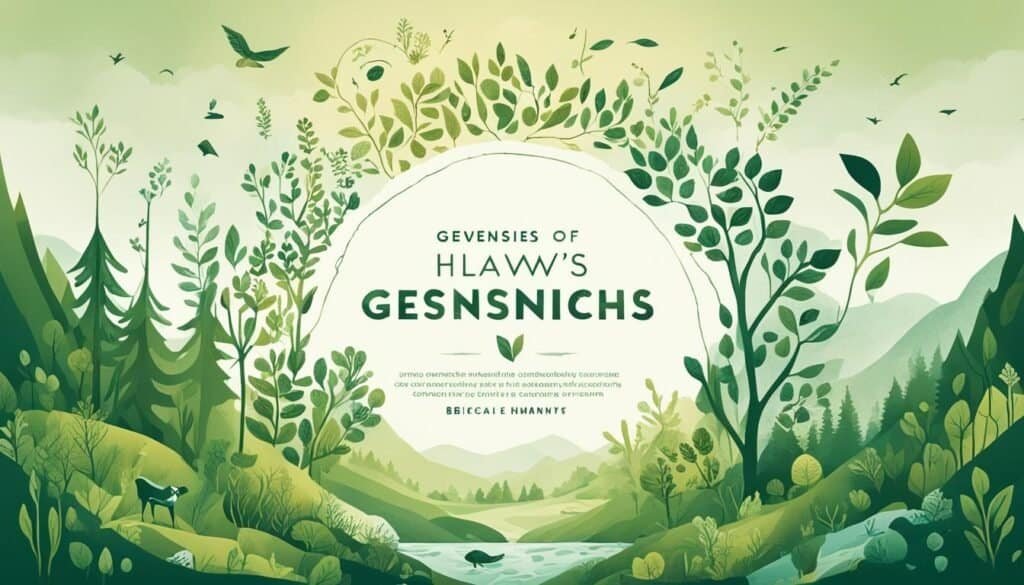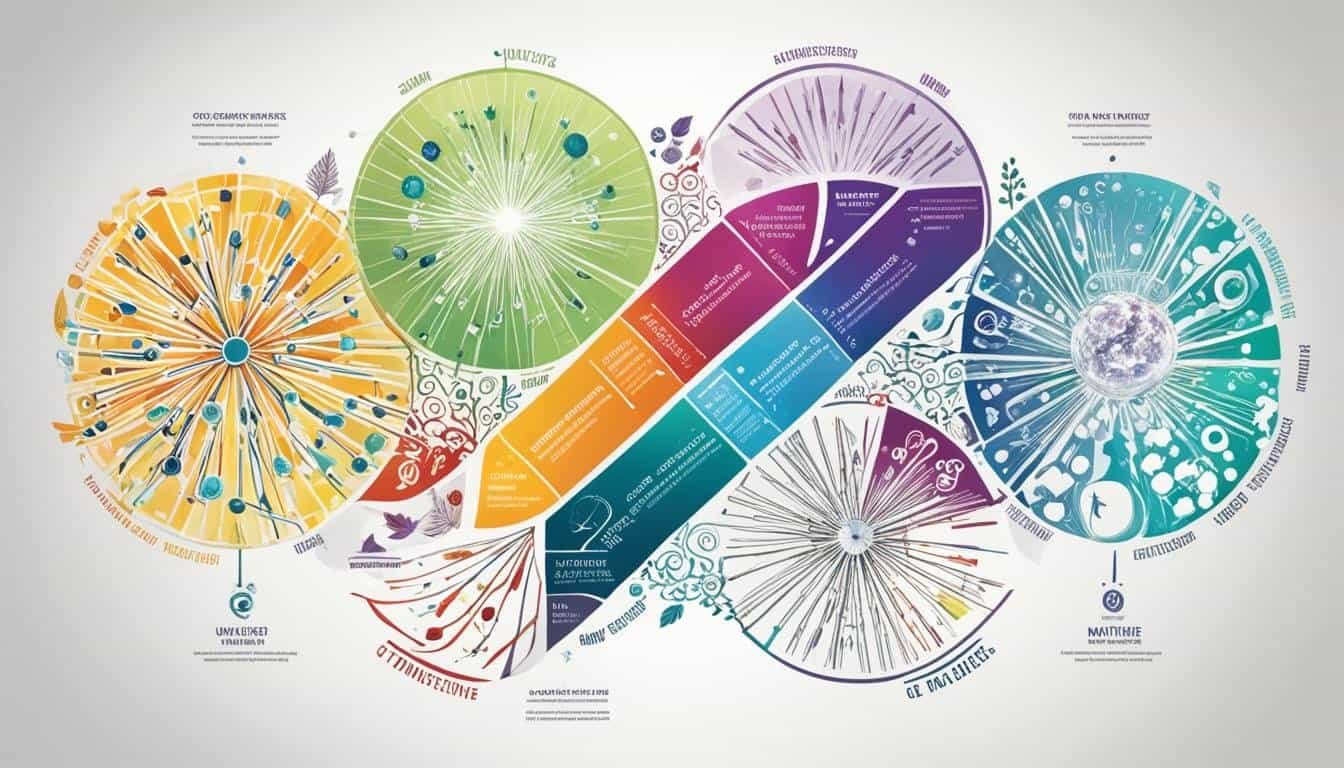10 Laws of Nature and Science Affirmed in Genesis
Genesis tells a powerful story that shows the universe’s order and balance. It highlights the structured cosmos. This text matches what science tells us about the laws that shape our world. So, let’s look at how Genesis and science both point to a well-ordered and designed universe.
The story of creation in Genesis is detailed and organized. This mirrors how science sees the universe’s creation. It starts with light and dark, and later continues with the separation of land and water. This creation story, while not exactly a scientific account, reflects the universe’s order and purpose.
Genesis’ detailed accounts match the current understanding of a structured cosmos. This ancient text still captivates us today. Looking at the ten laws in Genesis, we see a blend of biblical and scientific wisdom. Both reveal the beauty of our reality.
| Law of Nature and Science | Corresponding Genesis Account |
|---|---|
| Law of Gravity | Genesis 1:6-8 – Separation of the “waters above” and “waters below” |
| Law of Thermodynamics | Genesis 2:1-3 – The creation of the universe in six days, followed by a day of rest |
| Law of Biological Diversity | Genesis 1:11, 20-21, 24-25 – The creation of various kinds of plants and animals |
| Law of Cause and Effect | Genesis 1:3-25 – The sequential nature of creation, with each day representing a distinct phase |
| Law of Conservation of Mass and Energy | Genesis 1:1-3 – The creation of light before physical objects |
| Law of Molecular Attraction | Genesis 1:9-10 – The division of land and water to form distinct landmasses and oceans |
| Law of Cycles and Rhythms | Genesis 1:14-19 – The establishment of patterns in celestial bodies, including days, weeks, and seasons |
| Law of Harmony | Genesis 1:31 – The declaration that everything created was “very good” |
| Law of Complexity | Genesis 1:26-28 – The creation of humans “in God’s image,” showcasing unique cognitive abilities |
| Law of Emergence | Genesis 1:2 – The spirit of God “hovering over the waters,” initiating a transformative process |
This table shows the fascinating connection between Genesis and science. It highlights the harmonious order in our universe. Both biblical insights and scientific findings reveal the immense beauty of our world.
The Reflection of the Day/Night Cycle in Genesis
The Bible tells a story in Genesis that matches scientific facts about the Earth. In this story, light gets separated from dark, much like our day/night cycle today. This is how the Bible described Earth’s rotation many years ago.
Since the earliest times, understanding the day and night has been vital. Genesis describes how God created light and separated it from dark. This marked the first signs of a rotating Earth and the start of our daily cycle.
The Earth spinning creates the change from day to night. Different parts of the globe face the sun, causing daylight or nighttime. So, the Bible and science agree on how this cycle works.
Comparing Genesis with what science tells us shows how people long ago noticed nature’s patterns. The writers knew about the regular shifts between day and night. This means they were closely connected to the world around them.
The day/night cycle affects our entire world. It sets our sleep times, affects our bodies, and influences nature’s processes. It’s essential for all living things and their daily activities.
Seeing the link between the Bible and the day/night cycle is recognizing a balance. It shows how faith and science can complement each other. It also highlights the beauty of nature and our efforts to comprehend it.
The Significance of the Day/Night Cycle
A unified view of the day/night cycle from both science and religion is inspiring. It reminds us of the harmony and beauty in our world.
Studying the connections between old wisdom and new discoveries enriches us. Observing the day/night cycle in Genesis reveals deep truths. Being open to what ancient texts say can lead us to appreciate the universe more.
| Reflections on Genesis | The Day/Night Cycle |
|---|---|
| Highlights the order and design within the universe | Reflects the Earth’s rotation and its impact on our planet’s cycles |
| Recognizes the rhythmic patterns of day and night | Corroborates the natural phenomenon of the Earth spinning on its axis |
| Highlights the importance of the day/night cycle in shaping our daily lives | Emphasizes its role in regulating sleep patterns, influencing physiology, and impacting ecological processes |
| Showcases the harmony between faith and science | Illustrates the inherent order and coherence in the natural world and our ongoing quest to understand it |
The Division of Land and Water in Genesis
In the Bible’s book of Genesis, we find a deep story about land and water’s creation. It matches what we see in the real world – different lands and vast oceans. These are vital parts of our planet’s makeup.
The Bible makes a big idea of land and water being separate, just like nature proves. Lands vary from mountains to plains, making unique spaces for life. Meanwhile, oceans are rich in life and help keep Earth’s climate in balance.
Genesis talks about how land and water are divided, fitting perfectly with our scientific view. Earth has various continents, islands, and seas. This mix creates different areas where all kinds of life thrive.
Around three-quarters of Earth is covered in water by huge oceans. These include the Pacific and Atlantic Oceans. Oceans are key in controlling weather, absorbing the sun’s heat, and moving it worldwide.
Let’s learn more about land and water by looking at a visual representation:
| Landmasses | Oceans |
|---|---|
| 1. Africa | 1. Pacific Ocean |
| 2. Asia | 2. Atlantic Ocean |
| 3. Europe | 3. Indian Ocean |
| 4. North America | 4. Southern Ocean |
| 5. South America | 5. Arctic Ocean |
| 6. Australia | |
| 7. Antarctica |
The table clearly shows how Earth’s land and water are divided. It highlights the link between the Bible’s stories and our planet. This makes us think about how the Bible connects with what science tells us.
Keep reading Genesis to see more about how its stories and our world’s wonders are linked.

The Primacy of Light and Energy in Genesis
In Genesis, light and energy take the lead in creating the universe. The story tells us light came first, even before physical objects.
This matches what we know from science. Light and energy are crucial for the structure and growth of stars and planets.
“And God said, ‘Let there be light,’ and there was light.” – Genesis 1:3
This line from Genesis shows God’s creative power. It also links energy with the beginning of physical things. Light and energy are described as starting points for everything else.
Scientifically, we view light as fundamental energy. It drives universal growth, creating stars and galaxies.
Looking at the electromagnetic spectrum helps understand this. It includes not only light but also other energy types we can’t see.
This idea from Genesis suggests energy started it all. It points to energy as the beginning of our world’s development.
Today, science agrees energy shapes the universe. Everything from starlight to dark energy influences our world.
Stars, which are full of light and energy, illustrate this perfectly. They need an immense amount of energy to shine. This energy comes from their birth process.
From their formation, stars emit both light and heat. They are key elements in cosmic creation, echoing Genesis’s narrative.
Light as a Metaphor
Genesis uses light as more than a physical term. It stands for wisdom, guidance, and spiritual insight. Throughout the Bible, light symbolizes divine truth and knowledge.
This metaphor underscores light’s importance in Genesis. It means not just physical creation but also spiritual enlightenment. Light represents divine understanding and truth.
Exploring Genesis and scientific insights about light deepens our understanding. It shows how religious and scientific views can align.
| Genesis | Science |
|---|---|
| Light created before physical objects | Light and energy as fundamental forces in the universe |
| Energy as the driving force behind creation | Energy shaping the formation of stars, galaxies, and cosmic structures |
| The metaphorical significance of light in conveying wisdom and divine presence | Light as a symbol of knowledge, enlightenment, and the pursuit of truth |
The Potential Reference to Gravity in Genesis
Genesis talks about the “firmament,” separating waters from above and below. There are many thoughts on what this means. But it’s cool to think about how it might link to our understanding of gravity.
Gravity is super important. It shapes our world and keeps things in their place. This powerful force also makes sure everything in space stays in order.
Looking at Genesis and what science says, the firmament could be about gravity’s role. It symbolizes an invisible force keeping everything in balance on Earth.
Scientists have worked hard to figure out gravity. They started with Sir Isaac Newton and kept going with Albert Einstein. Our understanding of this key force keeps growing.
It’s amazing how the Bible and science highlight gravity. They both show how a force controls everything in the universe.
Seeing the possible gravity link in Genesis makes us see its beauty. It shows the connections between ancient stories and our modern exploration. This makes us want to understand our world better.

| Biblical Account | Scientific Understanding |
|---|---|
| The firmament, separating the waters above and below | The force of gravity shapes the Earth’s atmosphere and surface |
| The concept of an invisible force maintaining equilibrium | Gravity organizes and stabilizes celestial bodies and earthly phenomena |
| The recognition of harmony and order in the universe | Scientific insights affirm the fundamental role of gravity in maintaining cosmic balance |
The Sequential Nature of the Creation Story in Genesis
The story of creation in Genesis is told step by step, in an engaging way. It talks about how everything came into being, following a certain order. This order shows a clear path from start to finish.
It all begins with the making of light. Then, the waters are divided next. Land appears and plants grow. Finally, humans are created last.
This way of telling the creation story matches how we think about time and actions. It explains that things happen one after the other. And each step leads to the next one.
Genesis uses this order to show there is a plan in how the world was made. This plan underlines how our world is very organized. It’s like a blueprint for how everything comes together.
“And God said, ‘Let there be light,’ and there was light.”
The Order of Creation in Genesis
Let’s look at how Genesis details the making of different parts of the world. It happens in a specific sequence:
- The creation of light on the first day.
- The separation of waters and the formation of the sky on the second day.
- The emergence of dry land and the creation of vegetation on the third day.
- The formation of the sun, moon, and stars on the fourth day.
- The creation of sea creatures and birds on the fifth day.
- The creation of land animals and human beings on the sixth day.
These steps show us the clear, ordered way the world was created.
The Significance of Sequence
Genesis’ ordered creation story means a lot. It shows the world is not just random. Instead, it has a design and follows a plan. This idea lines up with how science sees the world, as something that follows a clear order.
“And God said, ‘Let there be light,’ and there was light.”
The Acknowledgement of Biological Diversity in Genesis
In Genesis, we see a stunning view of the natural world. It talks about the many plants and animals on Earth. This ancient text shows us how diverse life on our planet is.
Genesis tells us about creating different species. It shows how all life in our ecosystems is connected. The book celebrates the beauty and complexity of the world around us.
Looking at this story from a scientific view, we see something amazing. It matches what we know today about the many species on Earth. Scientists have found and named a huge number of plants and animals. They all play a part in keeping our planet’s balance.
From the rich rainforests with unique plants to the animals in every corner, Genesis talks about the same wonders we explore today. It shows us how amazing and complex our natural world truly is.
“The vast tapestry of life, with its various kinds of plants and animals, is a testament to the incredible intricacy and beauty of the natural world.”
Understanding and valuing the diversity in Genesis helps us see the big picture. We learn about the deep connections between all living things. And the need to care for and protect our planet becomes clear.

Examples of Biological Diversity
| Category | Examples |
|---|---|
| Plant Kingdom | Flowering plants, mosses, ferns, conifers |
| Animal Kingdom | Mammals, birds, reptiles, amphibians, fish, insects |
| Microorganisms | Bacteria, fungi, protozoa, viruses |
| Ecosystems | Tropical rainforests, coral reefs, grasslands, deserts |
Studying biology shows us the miracles of life. Let’s always remember the lessons of Genesis. We must protect the many plants and animals that make our world so special.
Humanity’s Special Place in Genesis
Genesis teaches us that humans are special because we were made “in God’s image.” This makes us different from all other creatures. It connects biblical stories with deep conversations about what it means to be human. This mix of religion, philosophy, and science is fascinating.
The idea that we are like God makes many people think. It shows that we are important and that we can know God. This makes everyone valuable and shows that we all fit into a bigger plan.
“And God said, ‘Let us make man in our image, after our likeness… So God created man in his own image, in the image of God he created them; male and female he created them.'” (Genesis 1:26-27)
This view of humanity digs deep into what makes us really human. Science looks at our bodies, but the idea of being like God is about more. It’s about our minds, spirits, and our ability to know right from wrong.
This special place for people doesn’t mean we don’t care about the world or other animals. It means we have an important role. We should look after the Earth. This is because we can think, feel, and choose in a way that is special.
Thinking about what makes us different is a powerful reminder of how we’re all connected. It tells us to treat everyone with respect and kindness. This is true no matter how different we seem from each other.
Genesis makes us think about the big questions of life. Who are we? What is our role in the world? It tells us we are all special, brought to life by God. This has always been a way to bring people closer, with respect and care for the whole human family.
Exploration of Human Consciousness
Talking about being created “in God’s image” also leads to looking at our minds. Many experts study this, from different fields. They ask about our thoughts, how we feel about ourselves, and how our minds and bodies are connected.
The idea that we reflect God makes us think deeply about our minds. It’s about finding a connection between our thoughts, feelings, and God. This goes beyond just what we see. It’s about asking really big questions about life and meaning.
By looking at our minds and how we figure out right from wrong, we learn more about this idea. An the idea of being made in God’s image starts to make sense. We see a link between what we can know and believe, in a way that makes us think deeply.
Genesis helps us think about what it means to be human in a big world. It says we’re linked to the divine. This encourages awe, thankfulness, and caring for each other. We are in this journey of life together, with God guiding us. It’s all about learning and growing in a way that respects the world and all people.

The Establishment of Cycles and Rhythms in Genesis
In the book of Genesis, we explore stories of creation. We find deep insights into the world around us. Genesis shows us cycles and rhythms in the patterns of days, weeks, and the lunar cycle.
In the story of creation, light and darkness are made. This starts the flow of time. Each day is a clear phase with morning and evening showing time passing. Our daily lives follow this cycle.
God then makes the sun, moon, and stars on the fourth day. These heavenly bodies help us track time and mark calendars. This shows the importance of cycles in our world.
The Weekly Cycle and the Sabbath
Genesis gives us the idea of a seven-day week tied to the creation story. This pattern shapes our lives and how we view time. It’s a part of almost every culture.
It’s not just about culture. Plants and animals follow the weekly cycle too. This shows how connected we are to nature through the seven-day week.
The Sabbath is a special day of rest. It reminds us to value time and the natural cycles of life. It allows us to pause from our work.
“As we embrace the rhythm of the weekly cycle, we can honor the work, rest, and renewal that permeate our lives.”
Appreciating the Natural Order
Genesis teaches us about the world’s order, showing how everything is connected. The sun, seasons, and more are part of a beautiful design.
Understanding these patterns helps us see the world as ordered and designed. It mirrors the order we read about in Genesis. This makes the world’s beauty clear.
Genesis’ cycles go beyond telling time. They highlight the balance and harmony all around us. They call us to find meaning in every moment.
| Cycles and Rhythms in Genesis | Significance |
|---|---|
| Pattern of Days | Establishes the concept of time and the cyclical nature of life |
| Creation of Celestial Bodies | Indicates the correlation between heavenly bodies and the marking of seasons, days, and years |
| The Seven-Day Week | Reflects both religious and natural patterns, uniting cultural practices with the rhythms observed in nature |
| The Sabbath | Provides a dedicated time for rest and reflection, reinforcing the importance of honoring cycles and rhythms |
The Dynamic Process of Change and Development in Genesis
The book of Genesis tells a powerful story. It shows us how the universe was created. More importantly, it talks about how everything changes and grows. This link between what Genesis says and what science shows us is fascinating. It encourages us to think about how faith and science relate.
Genesis doesn’t just talk about a moment of creation. It shows us a universe that is always changing. Science agrees. Our universe is a place of constant movement and growth. This happens from the start of new stars to the development of life.
When we look at Genesis, we see how amazing the universe really is. This world we live in is always changing yet always in balance. It’s a reminder of the creative forces working in our universe. Whether from a religious or scientific view, we find wonder in how everything comes together. This makes us curious and eager to learn more about the world around us.
Affiliate Disclosure: "As an Amazon Associate I earn from qualifying purchases made from links in this post. We are a participant in the Amazon Services LLC Associates Program, an affiliate advertising program designed to provide a means for us to earn fees by linking to Amazon.com."

